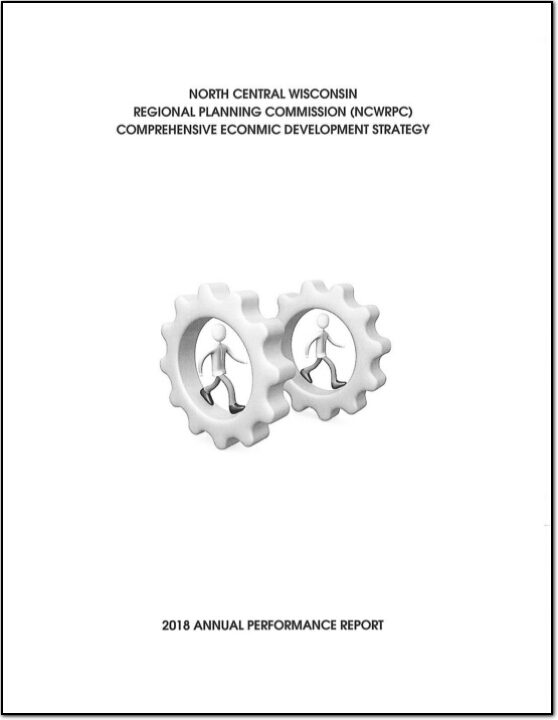January 29, 2020 – Agenda
Comprehensive Economic Development Strategy 2020 Annual Performance Report
An assessment of economic development activities of the North Central Wisconsin Regional Planning Commission over the last decade and the past year. The report’s seven sections describe the CEDS Committee, Past Year’s Activities, the Physical Region, Changes in the Region’s Population, changes in the Region’s Economy, a Regional Development Strategy, and an Economic Development Work Plan. Also included is a list of potential public works projects. This CEDS process maintains the Region’s eligibility as an Economic Development District (EDD) with the U.S. Economic Development Administration. The District consists of ten counties. These counties are Adams, Forest, Juneau, Langlade, Lincoln, Marathon, Oneida, Portage, Vilas, and Wood. However, Portage, and Wood Counties do not fully participate in the EDD – only some local communities with these two Counties participate.
Annual Report 2019
The Annual Report is prepared to provide interested local, state, and federal officials as well as citizens with an overview of the activities undertaken by the NCWRPC over the last year. The report highlights our five core work areas:
• Economic Development
• Geographic Information Systems
• Intergovernmental Cooperation
• Land Use, and
• Transportation
In addition, the report meets the requirements as outlined in Wisconsin Statute 66.0309(8)(b) for annual report preparation. This is our 46th Annual Report. With your continued support, we look forward to another successful year in 2020.
Comprehensive Economic Development Strategy 2019 Annual Performance Report
An assessment of economic development activities of the North Central Wisconsin Regional Planning Commission over the last decade and the past year. The report’s seven sections describe the CEDS Committee, Past Year’s Activities, the Physical Region, Changes in the Region’s Population, changes in the Region’s Economy, a Regional Development Strategy, and an Economic Development Work Plan. Also included is a list of potential public works projects. This CEDS process maintains the Region’s eligibility as an Economic Development District (EDD) with the U.S. Economic Development Administration. The District consists of ten counties. These counties are Adams, Forest, Juneau, Langlade, Lincoln, Marathon, Oneida, Portage, Vilas, and Wood. However, Portage, and Wood Counties do not fully participate in the EDD – only some local communities with these two Counties participate.
Annual Report 2018
The Annual Report is prepared to provide interested local, state, and federal officials as well as citizens with an overview of the activities undertaken by the NCWRPC over the last year. The report highlights our five core work areas:
• Economic Development
• Geographic Information Systems
• Intergovernmental Cooperation
• Land Use, and
• Transportation
In addition, the report meets the requirements as outlined in Wisconsin Statute 66.0309(8)(b) for annual report preparation. This is our 45th Annual Report. With your continued support, we look forward to another successful year in 2019.
North Central Wisconsin Regional Bicycle and Pedestrian Plan
The North Central Wisconsin Regional Bicycle and Pedestrian Plan is one of the first steps to implementing the Regional Livability Plan. This plan will analyze bicycle and pedestrian transportation throughout the Region, and recommend policies, programs, and facilities to improve the safety, viability, convenience, and attractiveness of bicycling and walking for transportation.
This Regional Plan is intended to bridge the gap between the largely policy-based State plans and local community planning for bicycle and pedestrian networks. Many communities and counties within our Region have invested in bicycling and walking improvements, but these improvements often end at the boundary of the jurisdictions that planned them. This Regional Plan serves as a guide to help these communities and counties connect across their boundaries to form a complete Regional network of safe walking and bicycling.

Comprehensive Economic Development Strategy 2018 Annual Performance Report
An assessment of economic development activities of the North Central Wisconsin Regional Planning Commission over the last decade and the past year. The report’s seven sections describe the CEDS Committee, Past Year’s Activities, the Physical Region, Changes in the Region’s Population, changes in the Region’s Economy, a Regional Development Strategy, and an Economic Development Work Plan. Also included is a list of potential public works projects. This CEDS process maintains the Region’s eligibility as an Economic Development District (EDD) with the U.S. Economic Development Administration. The District consists of ten counties. These counties are Adams, Forest, Juneau, Langlade, Lincoln, Marathon, Oneida, Portage, Vilas, and Wood. However, Portage, and Wood Counties do not fully participate in the EDD – only some local communities with these two Counties participate.

Profile – Wisconsin Regional Planning Commissions
Over the years, the demands on the regional planning commission (RPCs) have changed. These changes, however, have not altered the basic advisory role of the commissions. The original and traditional role of the commissions was to plan for the physical development of the areas they served. This involved planning issues, such as land use, transportation, natural resources, and water and sewer services. While this function has continued to be important, technical assistance in such areas as economic development, grant and loan services, and local government management.

Annual Report 2017
The Annual Report is prepared to provide interested local, state, and federal officials as well as citizens with an overview of the activities undertaken by the NCWRPC over the last year. The report highlights our five core work areas:
• Economic Development
• Geographic Information Systems
• Intergovernmental Cooperation
• Land Use, and
• Transportation
In addition, the report meets the requirements as outlined in Wisconsin Statute 66.0309(8)(b) for annual report preparation. This is our 44th Annual Report. With your continued support, we look forward to another successful year in 2018.